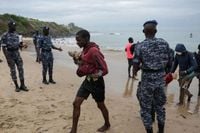On the morning of September 16, 2025, the usually calm shores of Dakar’s Ouakam neighborhood became the scene of a dramatic and all-too-familiar event. A long wooden fishing boat—known locally as a pirogue—carrying more than 100 migrants, ran aground, its desperate passengers hoping to reach Europe by way of the perilous Atlantic Ocean route to Spain’s Canary Islands. According to Arab News, nearly 100 migrants were aboard, though Reuters later reported the number as 112. The incident underscores the ongoing crisis of irregular migration from West Africa, a journey fraught with danger but driven by hope and hardship.
The pirogue’s journey was anything but smooth. Local fishermen were the first to spot the vessel drifting offshore, clearly in distress and lacking an engine. In a gesture of compassion, the fishermen lent the migrants a motor, allowing them to approach the coast before they were intercepted by Senegalese marines. Abdou Aziz Guèye, mayor of Ouakam, described the scene as deeply distressing. “We were informed of the interception of a pirogue full of migrants who wanted to leave for Europe,” Guèye told Arab News. He added, “It is a distressing sight. The captain reportedly fled with the engine.” The boat’s journey, it turns out, did not start in Ouakam, and local authorities are still investigating its true origins and the circumstances that led to its engine’s disappearance.
As the sun rose higher, local police quickly established a temporary processing center on the beach to conduct identity checks on the passengers. One of the migrants, shivering under the watchful eyes of Senegalese gendarmes, told Reuters that the group was from neighboring Gambia and had been at sea for five harrowing days. The passengers, all young men according to the mayor, had risked everything for the chance of a new life across the sea.
This latest incident is just one chapter in a much larger story. The Atlantic crossing from West Africa to the Canary Islands has reemerged as a major migrant transit route since 2020. The numbers are staggering: Spanish Interior Ministry figures cited by Arab News reveal that nearly 47,000 people disembarked in the Canaries in 2024, up from nearly 40,000 in 2023. Many make the journey in pirogues—large, open-top boats that are often overcrowded and ill-equipped for the treacherous voyage.
But why do so many risk their lives on this deadly route? The reasons are complex and deeply rooted. Experts interviewed by Reuters point to a toxic mix of economic hardship, political instability, and the growing impact of climate change on traditional livelihoods in West Africa. As agriculture and fishing become less reliable due to shifting weather patterns and overfishing, young people see few options at home. The hope of a better life in Europe, however distant or uncertain, is enough to push them to the edge.
“Illegal emigration is not over. It’s a phenomenon that continues,” Guèye warned, cautioning others against making the same risky journey. While the majority of migrants leaving Senegal are still young men, aid workers in the Canary Islands have noticed a troubling trend: more women and children are now risking the journey as well.
Despite increased cooperation between European and West African nations, the flow of migrants has not slowed. Last year, the European Union signed a 210 million euro deal with Mauritania aimed at stopping smugglers from launching boats to Spain. Yet, as the statistics show, trans-Atlantic migration from West Africa has persisted, even as irregular border crossings in Europe have fallen steadily overall.
The Atlantic crossing remains one of the deadliest migration routes in the world. There is no precise death toll, in part because so many boats vanish without a trace, but the Spanish migrant rights group Walking Borders estimates that thousands have died attempting the journey in 2025 alone. The lack of accurate information on departures from West Africa makes it impossible to know the true scale of the tragedy.
Senegalese authorities, for their part, have stepped up patrols in recent years, hoping to intercept boats before they reach open water. Yet, as Tuesday’s events show, migrants continue to take their chances, often in overcrowded and poorly maintained vessels. The seasonal rhythms of the Atlantic play a role as well: in Senegal, the winter months see a spike in attempted crossings as calmer seas make the voyage slightly less perilous. However, migrants are willing to risk the crossing throughout the year, undeterred by the dangers.
The story of the Ouakam pirogue is emblematic of the broader crisis. The migrants’ journey was cut short by fate and the vigilance of local fishermen, but for thousands of others, the outcome is far less certain. The mayor’s account reveals the desperation and resourcefulness that define these crossings—fishermen lending engines, captains fleeing into the unknown, and young men huddled on the sand, caught between hope and heartbreak.
Authorities have launched an investigation to determine exactly where the vessel originated and how it came to be stranded without an engine. The outcome may shed light on the shadowy networks of smugglers who profit from human desperation, even as governments on both sides of the Atlantic try to clamp down on their activities.
For now, the migrants intercepted in Ouakam face an uncertain future. Police processing will determine their identities and, likely, their next steps—whether that means repatriation, detention, or, for a lucky few, a chance to seek asylum. But the larger forces driving migration from West Africa remain stubbornly in place: poverty, instability, and the slow violence of climate change.
As the sun set on Dakar, the pirogue that had carried so many dreams lay beached and empty, a silent testament to the risks people will take in search of a better life. The numbers may fluctuate, and the routes may change, but the underlying story—of hope, hardship, and the unyielding desire for a future—continues to unfold along the Atlantic shores of West Africa.




